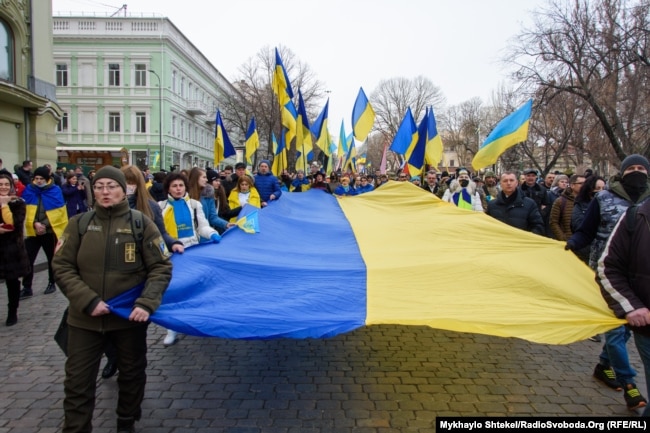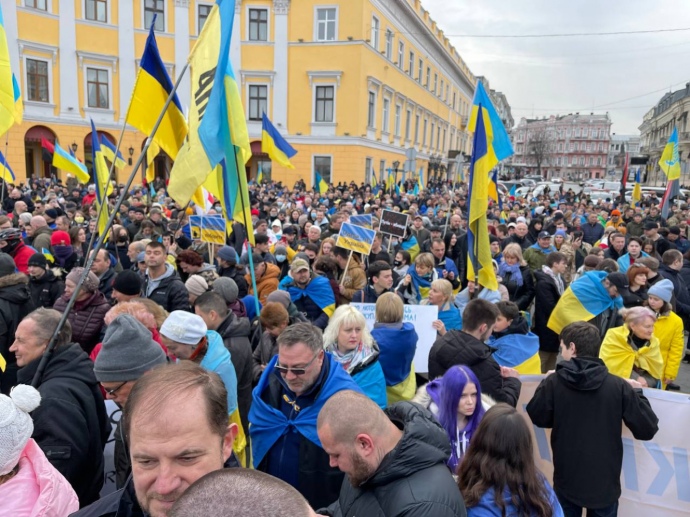Past 24 hours in the war zone
Escalation and disinformation continue.
- On 19 February, Russian-controlled forces launched 136 attacks on Ukrainian positions in Donetsk, Luhansk, and Mariupol sectors, including 116 involving heavy artillery and other weapons banned by the Minsk accords, according to Ukraine’s Joint Forces Operation Staff.
- As of 19:30 Feb 18, OSCE’s Special Monitoring Mission recorded 591 violations, including 553 explosions in Donetsk Oblast; 975 violations, including 860 explosions in Luhansk Oblast.
- On 19 February, a delegation of Ukrainian MPs, Interior Minister Monastyrsky, and foreign journalists come under fire in the war zone in the Donbas.
- Russian military and special services are preparing terrorist acts in the occupied territories to bring Russian armed forces into Ukraine under the guise of “peacekeepers,” announced Commander-in-Chief of the Armed Forces of Ukraine Valeriy Zaluzhnyi.
- Russia has increased military contingent on Ukrainian border to 190,000 soldiers, states US Ambassador to OSCE Michael Carpenter.
Kyiv defense experts: full-scale Russian invasion still unlikely, but high risk of attacks in east and south
A full-scale Russian occupation of Ukraine and massive bombing of Ukrainian cities is still unlikely. Yet a “false flag” event, an attempt to expand the occupied territory in eastern Ukraine, and a non-military hybrid war escalation are highly probable, say experts of the Center for Defense Strategies in Kyiv.
Kyiv defense experts: Russian proxies may attempt to expand occupied territory
Russian troops massed around Ukraine now ready for ‘various offensive scenarios’: digital sleuths
As all eyes are on the east-Ukrainian Donbas region, Russian troops massed around Ukraine continue preparing for a possible offensive.
“We believe at the moment they are ready to execute various offensive scenarios,” says the Conflict Intelligence Team (CIT) of digital sleuths.
Russian troops massed around Ukraine now ready for ‘various offensive scenarios’: digital sleuths
“LDNR” mobilization designed to sow panic, cover possible engagement of Russian regulars: Opinion
Amid Russia’s escalation in Ukraine’s Donbas region and attempts to create false-flag pretexts to invade Ukraine, the illegal general mobilization ordered by the occupation authorities of Donetsk and Luhansk (“DNR” and “LNR”) on 19 February is nothing but an attempt to cover the possible engagement of Russian regular troops, and sow panic among locals, believes an inhabitant of Donetsk Oblast living under Russian occupation.
Having access to the occupation force’s military sources, he states that “DNR” wouldn’t fling the forcefully conscripted locals into battle, because in case of a new hot phase in the Donbas war, the occupation authorities count on Russian regular forces to step in again as they did before.
“LDNR” mobilization designed to sow panic, cover possible engagement of Russian regulars: Opinion
Roughly 75% of Russian conventional forces deployed against Ukraine, US official says
According to the latest US intelligence assessment, Russia now has close to 75% of its conventional forces postured against Ukraine, a US official with direct knowledge of the intelligence told CNN. The concentration of forces within striking distance of Ukraine is highly unusual and part of the reason the US believes Russia is ready to attack, the official said.
Russian troops unsurprisingly stay in Belarus after the end of joint drills
Belarus’s defense minister, Gen Viktor Khrenin, said Russian soldiers would stay after large-scale joint drills were completed on Feb 20. He states the move was necessary because of the “escalation of the situation” in the Donbas, in the east of Ukraine, some 600km away from Belarus.
Russia closes airspace over Sea of Azov starting at midnight
Russia’s Aeronautical Information Center issued a NOTAM (a Notice to Airmen) on Feb 20 which will close most of the airspace over the Sea of Azov starting at midnight between Feb 20 and Feb 21.
“Staged Donbas ‘evacuation’ in Russia’s war against Ukraine. Where are the sanctions?”
“Sanctions are needed now, especially given the ease with which the supposed ‘mobilization’ announced in D-LNR (‘LNR’/’DNR’ – Ed.) can be used as a front to explain a large influx of Russian soldiers without insignia.,” wrote Halya Coynash of the Kharkiv Human Rights Protection Group.
Three Russian regions on Ukrainian border declare ‘regional emergency regime’
The state of emergency was introduced in Russia’s Kursk Oblast “in connection with the reception of a large number of refugees from the Donbas”, reports Interfax referring to the press service of the Russian Emergencies Ministry.
“Currently, due to the arrival of a large number of citizens of the Donbas, a regional emergency regime has been declared in a number of regions of the Russian Federation – Rostov, Voronezh, and Kursk oblasts,” the ministry reportedly said.
All three regions are adjacent to Ukraine, east and northeast.
‘They shoot, we hide’: Life amid shelling on Ukraine’s front line
Valentyna Hordeyeva realized something was coming when the tops of nearby fir trees started to shake but as she ran to shelter in a nearby shop, a shard of shrapnel pierced the soft flesh of her left hand.
“I was holding a bag and felt pain, and then I saw blood running down my bag,” the 65-year-old said, her thumb and wrist now bandaged after she became one of four civilians wounded in shelling by Russian-hybrid forces since 17 February.
Read Aljazeera’s reportage from Mariinka, the Ukrainian-held town near occupied regional capital Donetsk.
The Kremlin’s playbook: fabricating pretext to invade Ukraine – more myths
Recently, the EU disinformation watchdog EU vs Disinfo examined and debunked seven of the most prevalent and dangerous myths related to Ukraine. The EU vs Disinfo has compiled an overview of some of the most prominent pro-Kremlin disinformation narratives that are or may be used as a pretext for further escalation of military aggression against Ukraine.
The Kremlin’s playbook: fabricating pretext to invade Ukraine – more myths
Thousands of Odesa residents marched on the March of Unity
Several thousand residents of the south-Ukrainian port city of Odesa took part in the March of Unity on Feb 20 to demonstrate their unity and readiness to defend the city and the country from any threats amind the looming Russian invasion with more than 150,000 Russian troops amassed near Ukrainian borders.


Rallies in solidarity with Ukraine
On 19-20 February, several #StandWithUkraine rallies of solidarity with Ukraine against Russian aggression took place across the globe. Here are photos of just a few of them.








The defeat that won’t repeat: Russia’s invasion of Ukraine a century ago & now
Russia’s invasion of Ukraine 100 years ago crushed its dreams of independence until 1991. Today’s war is being fought with nearly identical means, but this time, Ukraine has a chance.
The defeat that won’t repeat: Russia’s invasion of Ukraine a century ago & now






